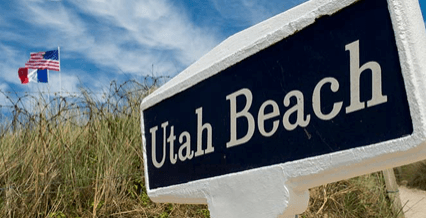I am fortunate to have married a history buff who insisted we add a trip to Normandy and the historic Beaches of WW II. It was an amazing experience. We headed out from Paris, spending the first night in Rouen and then based ourselves out of the Relais & Chateaux Clarance Hotel at the north end of the beaches.
We rented bicycles as the means of touring the beaches and surrounding countryside because we wanted an authentic tour of the area. During our travels, we stumbled upon an amazing local who lead us to a tiny building that housed a museum known only to the locals. Inside, sat an older gentleman referred to by the locals as the expert on local history. He shared with us his memories of the invasion when he was a boy and provided us a hand-written map that contained the Normandy battlefields, as well as, little known villages and roads that were perfect for accessing by bike. I doubt the natives would have been as helpful if we arrived by car and I believe they took a liking to us precisely because we rode up on bikes.
The ride from the museum to the beaches was fascinating because it took us past the hedgerows that proved lethal to soldiers of the invasion forces because they formed a natural defensive barrier that German forces used to their deadly advantage. Another interesting sight on the ride was the monument in every village, hamlet and crossroad honoring the local soldiers killed during WW I. The French casualties in the First World War were far greater than in WW II and that left an indelible impact on the French psyche.
The American Military Cemetery, the beaches and the cliffs of Pointe du Hoc are emotionally overwhelming and moving to a degree that is difficult to describe in words. Needless to say, these sights are awe inspiring and will make every American honored by the sacrifices made by our fathers and grandfathers in the name of freedom.
Our final stop was the village of Sainte Mere Eglise made famous in the film the Longest Day as the landing site for hundreds of U.S. paratroopers during the early hours of D Day invasion. The village is picturesque and is built around a stone square that is dominated by the church of the same name and made famous by a paratrooper whose chute was caught in the steeple and he spent the duration of the battle watching the fighting play out below him. In recognition of the American sacrifice, a replica of the paratrooper hangs in the steeple to this day. The square is surrounded by cafes that are a perfect place to sit back and enjoy this historic village.
On our way back to Paris we visited the charming picturesque seaside town of Honfleur – not to be missed and enjoyed a fabulous night at another Relais & Chateaux property La Ferme Saint-Simeon! Honfleur is a historic shipping port and the starting point for many French expeditions to the New World in the 16th and 17th centuries including Samuel Champlain. The buildings date back centuries and the shops and port are so picturesque. If you want to revisit world history to appreciate what our freedom means, make sure you head to Normandy.

